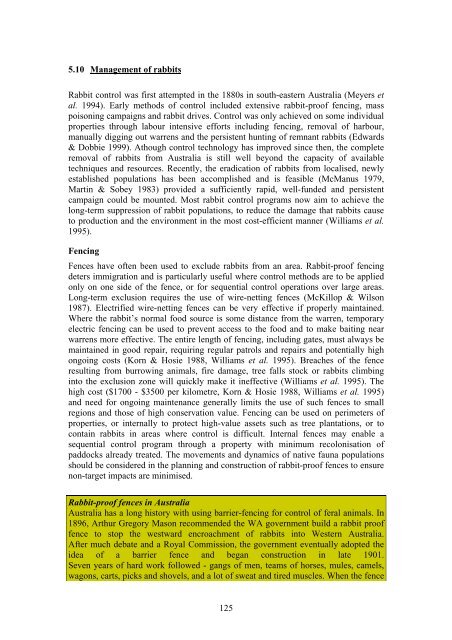Review of the management of feral animals and their impact on ...
Review of the management of feral animals and their impact on ...
Review of the management of feral animals and their impact on ...
You also want an ePaper? Increase the reach of your titles
YUMPU automatically turns print PDFs into web optimized ePapers that Google loves.
5.10 Management <str<strong>on</strong>g>of</str<strong>on</strong>g> rabbits<br />
Rabbit c<strong>on</strong>trol was first attempted in <str<strong>on</strong>g>the</str<strong>on</strong>g> 1880s in south-eastern Australia (Meyers et<br />
al. 1994). Early methods <str<strong>on</strong>g>of</str<strong>on</strong>g> c<strong>on</strong>trol included extensive rabbit-pro<str<strong>on</strong>g>of</str<strong>on</strong>g> fencing, mass<br />
pois<strong>on</strong>ing campaigns <str<strong>on</strong>g>and</str<strong>on</strong>g> rabbit drives. C<strong>on</strong>trol was <strong>on</strong>ly achieved <strong>on</strong> some individual<br />
properties through labour intensive efforts including fencing, removal <str<strong>on</strong>g>of</str<strong>on</strong>g> harbour,<br />
manually digging out warrens <str<strong>on</strong>g>and</str<strong>on</strong>g> <str<strong>on</strong>g>the</str<strong>on</strong>g> persistent hunting <str<strong>on</strong>g>of</str<strong>on</strong>g> remnant rabbits (Edwards<br />
& Dobbie 1999). Athough c<strong>on</strong>trol technology has improved since <str<strong>on</strong>g>the</str<strong>on</strong>g>n, <str<strong>on</strong>g>the</str<strong>on</strong>g> complete<br />
removal <str<strong>on</strong>g>of</str<strong>on</strong>g> rabbits from Australia is still well bey<strong>on</strong>d <str<strong>on</strong>g>the</str<strong>on</strong>g> capacity <str<strong>on</strong>g>of</str<strong>on</strong>g> available<br />
techniques <str<strong>on</strong>g>and</str<strong>on</strong>g> resources. Recently, <str<strong>on</strong>g>the</str<strong>on</strong>g> eradicati<strong>on</strong> <str<strong>on</strong>g>of</str<strong>on</strong>g> rabbits from localised, newly<br />
established populati<strong>on</strong>s has been accomplished <str<strong>on</strong>g>and</str<strong>on</strong>g> is feasible (McManus 1979,<br />
Martin & Sobey 1983) provided a sufficiently rapid, well-funded <str<strong>on</strong>g>and</str<strong>on</strong>g> persistent<br />
campaign could be mounted. Most rabbit c<strong>on</strong>trol programs now aim to achieve <str<strong>on</strong>g>the</str<strong>on</strong>g><br />
l<strong>on</strong>g-term suppressi<strong>on</strong> <str<strong>on</strong>g>of</str<strong>on</strong>g> rabbit populati<strong>on</strong>s, to reduce <str<strong>on</strong>g>the</str<strong>on</strong>g> damage that rabbits cause<br />
to producti<strong>on</strong> <str<strong>on</strong>g>and</str<strong>on</strong>g> <str<strong>on</strong>g>the</str<strong>on</strong>g> envir<strong>on</strong>ment in <str<strong>on</strong>g>the</str<strong>on</strong>g> most cost-efficient manner (Williams et al.<br />
1995).<br />
Fencing<br />
Fences have <str<strong>on</strong>g>of</str<strong>on</strong>g>ten been used to exclude rabbits from an area. Rabbit-pro<str<strong>on</strong>g>of</str<strong>on</strong>g> fencing<br />
deters immigrati<strong>on</strong> <str<strong>on</strong>g>and</str<strong>on</strong>g> is particularly useful where c<strong>on</strong>trol methods are to be applied<br />
<strong>on</strong>ly <strong>on</strong> <strong>on</strong>e side <str<strong>on</strong>g>of</str<strong>on</strong>g> <str<strong>on</strong>g>the</str<strong>on</strong>g> fence, or for sequential c<strong>on</strong>trol operati<strong>on</strong>s over large areas.<br />
L<strong>on</strong>g-term exclusi<strong>on</strong> requires <str<strong>on</strong>g>the</str<strong>on</strong>g> use <str<strong>on</strong>g>of</str<strong>on</strong>g> wire-netting fences (McKillop & Wils<strong>on</strong><br />
1987). Electrified wire-netting fences can be very effective if properly maintained.<br />
Where <str<strong>on</strong>g>the</str<strong>on</strong>g> rabbit’s normal food source is some distance from <str<strong>on</strong>g>the</str<strong>on</strong>g> warren, temporary<br />
electric fencing can be used to prevent access to <str<strong>on</strong>g>the</str<strong>on</strong>g> food <str<strong>on</strong>g>and</str<strong>on</strong>g> to make baiting near<br />
warrens more effective. The entire length <str<strong>on</strong>g>of</str<strong>on</strong>g> fencing, including gates, must always be<br />
maintained in good repair, requiring regular patrols <str<strong>on</strong>g>and</str<strong>on</strong>g> repairs <str<strong>on</strong>g>and</str<strong>on</strong>g> potentially high<br />
<strong>on</strong>going costs (Korn & Hosie 1988, Williams et al. 1995). Breaches <str<strong>on</strong>g>of</str<strong>on</strong>g> <str<strong>on</strong>g>the</str<strong>on</strong>g> fence<br />
resulting from burrowing <str<strong>on</strong>g>animals</str<strong>on</strong>g>, fire damage, tree falls stock or rabbits climbing<br />
into <str<strong>on</strong>g>the</str<strong>on</strong>g> exclusi<strong>on</strong> z<strong>on</strong>e will quickly make it ineffective (Williams et al. 1995). The<br />
high cost ($1700 - $3500 per kilometre, Korn & Hosie 1988, Williams et al. 1995)<br />
<str<strong>on</strong>g>and</str<strong>on</strong>g> need for <strong>on</strong>going maintenance generally limits <str<strong>on</strong>g>the</str<strong>on</strong>g> use <str<strong>on</strong>g>of</str<strong>on</strong>g> such fences to small<br />
regi<strong>on</strong>s <str<strong>on</strong>g>and</str<strong>on</strong>g> those <str<strong>on</strong>g>of</str<strong>on</strong>g> high c<strong>on</strong>servati<strong>on</strong> value. Fencing can be used <strong>on</strong> perimeters <str<strong>on</strong>g>of</str<strong>on</strong>g><br />
properties, or internally to protect high-value assets such as tree plantati<strong>on</strong>s, or to<br />
c<strong>on</strong>tain rabbits in areas where c<strong>on</strong>trol is difficult. Internal fences may enable a<br />
sequential c<strong>on</strong>trol program through a property with minimum recol<strong>on</strong>isati<strong>on</strong> <str<strong>on</strong>g>of</str<strong>on</strong>g><br />
paddocks already treated. The movements <str<strong>on</strong>g>and</str<strong>on</strong>g> dynamics <str<strong>on</strong>g>of</str<strong>on</strong>g> native fauna populati<strong>on</strong>s<br />
should be c<strong>on</strong>sidered in <str<strong>on</strong>g>the</str<strong>on</strong>g> planning <str<strong>on</strong>g>and</str<strong>on</strong>g> c<strong>on</strong>structi<strong>on</strong> <str<strong>on</strong>g>of</str<strong>on</strong>g> rabbit-pro<str<strong>on</strong>g>of</str<strong>on</strong>g> fences to ensure<br />
n<strong>on</strong>-target <str<strong>on</strong>g>impact</str<strong>on</strong>g>s are minimised.<br />
Rabbit-pro<str<strong>on</strong>g>of</str<strong>on</strong>g> fences in Australia<br />
Australia has a l<strong>on</strong>g history with using barrier-fencing for c<strong>on</strong>trol <str<strong>on</strong>g>of</str<strong>on</strong>g> <str<strong>on</strong>g>feral</str<strong>on</strong>g> <str<strong>on</strong>g>animals</str<strong>on</strong>g>. In<br />
1896, Arthur Gregory Mas<strong>on</strong> recommended <str<strong>on</strong>g>the</str<strong>on</strong>g> WA government build a rabbit pro<str<strong>on</strong>g>of</str<strong>on</strong>g><br />
fence to stop <str<strong>on</strong>g>the</str<strong>on</strong>g> westward encroachment <str<strong>on</strong>g>of</str<strong>on</strong>g> rabbits into Western Australia.<br />
After much debate <str<strong>on</strong>g>and</str<strong>on</strong>g> a Royal Commissi<strong>on</strong>, <str<strong>on</strong>g>the</str<strong>on</strong>g> government eventually adopted <str<strong>on</strong>g>the</str<strong>on</strong>g><br />
idea <str<strong>on</strong>g>of</str<strong>on</strong>g> a barrier fence <str<strong>on</strong>g>and</str<strong>on</strong>g> began c<strong>on</strong>structi<strong>on</strong> in late 1901.<br />
Seven years <str<strong>on</strong>g>of</str<strong>on</strong>g> hard work followed - gangs <str<strong>on</strong>g>of</str<strong>on</strong>g> men, teams <str<strong>on</strong>g>of</str<strong>on</strong>g> horses, mules, camels,<br />
wag<strong>on</strong>s, carts, picks <str<strong>on</strong>g>and</str<strong>on</strong>g> shovels, <str<strong>on</strong>g>and</str<strong>on</strong>g> a lot <str<strong>on</strong>g>of</str<strong>on</strong>g> sweat <str<strong>on</strong>g>and</str<strong>on</strong>g> tired muscles. When <str<strong>on</strong>g>the</str<strong>on</strong>g> fence<br />
125
















